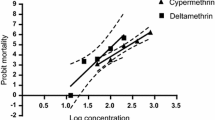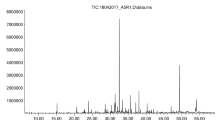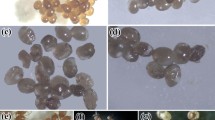Abstract
Larval packet test was used for detection of resistance status against cypermethrin and deltamethrin, the most commonly used synthetic pyrethroids in Rhipicephalus (Boophilus) microplus collected from Faridkot district, Punjab (India). The slope of mortality, lethal concentration for 50 % (LC50) and resistance levels were determined from the regression graphs of probit mortality of ticks plotted against log values of increasing concentrations of cypermethrin and deltamethrin. Results indicated presence of resistance of levels I and II against cypermethrin (resistance factor (RF) = 2.82) and deltamethrin (RF = 8.44), respectively. Adult immersion test was used to assess the acaricidal activity of aqueous (MLAq), ethanol (MLE), chloroform (MLC), acetone (MLA) and hexane (MLH) extracts of leaves of Murraya koenigii against these synthetic pyrethroid (SP)-resistant engorged adult females of R. (B.) microplus by determination of per cent adult mortality, reproductive index (RI), per cent inhibition of oviposition (%IO) and hatching rate. The per cent mortality caused by various extracts at concentrations ranging from 0.625 to 10.0 % varied from 0.0 to 100.0 % with maximum per cent mortality of 10.0, 100.0, 70.0, 40.0 and 10.0 recorded against MLAq, MLE, MLC, MLA and MLH, respectively. Among all extracts, the highest acaricidal property against SP-resistant R. (B.) microplus was exhibited by the MLE as it showed the minimum LC50 [95 % confidence limit (CL)] values of 2.97 % (2.82–3.12 %), followed by MLC as 10.26 % (8.84–11.91 %) and MLA as 18.22 % (16.18–20.52 %). The average egg mass weight recorded in live ticks treated with various concentrations of different extracts was lower than the respective control group ticks and was significantly (p < 0.01) lower in ticks treated with MLH extract. However, no significant effect on hatchability of eggs of treated groups when compared to control was recorded. A significant (p < 0.05) decrease in the RI was recorded in MLH extract-treated ticks, and the %IO varied from 0.07 to 34.73 % with various extracts and was recorded maximum with highest concentration of MLH. The results of the current study indicate that the extracts of M. koenigii can be used for control of SP-resistant ticks.





Similar content being viewed by others
References
Adebajo AC, Ayoola OF, Iwalewa EO, Akindahunsi AA, Omisore NO, Adewunmi CO, Adenowo TK (2006) Anti-trichomonal, biochemical and toxicological activities of methanolic extract and some carbazole alkaloids isolated from the leaves of Murraya koenigii growing in Nigeria. Phytomedicine 13:246–254
Borges LM, Ferri PH, Silva WJ, Silva WC, Silva JG (2003) In vitro efficacy of extracts of Melia azedarach against the tick Boophilus microplus. Med Vet Entomol 17:228–231
Castro-Janer E, Rifran L, Piaggio J, Gil A, Miller RJ, Schumaker TTS (2009) In vitro tests to establish LC50 and discriminating concentrations for fipronil against Rhipicephalus (Boophilus) microplus (Acari: Ixodidae) and their standardization. Vet Parasitol 162:120–128
Chagas ACS (2004) Controle de parasitas utilizando extratos vegetais. Rev Bras Parasitol Vet 13:156–160
Chevallier A (1996) The encyclopedia of medicinal plants. Dorlon Kindersley Publisher, London
Chungsamarnyart N, Jiwajinda S, Ratanakreetakul C, Jasawan W (1991) Practical extraction of sugar apple seeds against tropical cattle ticks. Kasetsart J (Nat Sci) 25:101–105
Cosa P, Vlietinck AJ, Berghe DV, Maes L (2006) Anti-infective potential of natural products: how to develop a stronger in vitro ‘proof-of-concept’. J Ethnopharmacol 106:290–302
Cowan MM (1999) Plant products as antimicrobial agents. Clin Microbiol Rev 12:564–582
de Castro JJ (1997) Sustainable tick and tick-borne disease control in livestock improvement in developing countries. Vet Parasitol 71:77–97
Devanand P, Rani PU (2008) Biological potency of certain plant extracts in management of two lepidopteran pests of Ricinus communis L. J Biopest 1:170–176
Drummond RO, Ernst SE, Trevino JL, Gladney WJ, Graham OH (1973) Boophilus annulatus and Boophilus microplus: laboratory test of insecticides. J Econ Entomol 66:130–133
FAO (1971) Recommended methods for the detection and measurement of resistance of agricultural pests to pesticides-tentative method for larvae of cattle tick, Boophilus microplus spp. FAO method No. 7. FAO Plant Prot Bull 19:15–18
Fernandez-Salas A, Alonso-Diaz MA, Acosta-Rodriguez R, Torres-Acosta JF, Sandoval-Castro CA, Rodriguez-Vivas RI (2011) In vitro acaricidal effect of tannin-rich plants against the cattle tick Rhipicephalus (Boophilus) microplus (Acari: Ixodidae). Vet Parasitol 175:113–118
Finney DJ (1962) Probit analysis—a statistical treatment of the response curve. Cambridge University Press, Cambridge, pp 1–318
Ghosh S, Bansal GC, Gupta SC, Ray DD, Khan MQ, Irshad H, Shahiduzzaman M, Seitzer U, Ahmed JS (2007) Status of tick distribution in Bangladesh, India and Pakistan. Parasitol Res 101:S207–S216
Ghosh S, Sharma AK, Kumar S, Tiwari SS, Rastogi S, Srivastava S, Singh M, Kumar R, Paul S, Ray DD, Chaudhuri P, Rawat AKS (2011) In vitro and in vivo efficacy of Acorus calamus extract against Rhipicephalus (Boophilus) microplus. Parasitol Res 108:361–370
Ghosh S, Tiwari SS, Srivastava S, Sharma AK, Kumar S, Ray DD, Rawat AK (2013) Acaricidal properties of Ricinus communis leaf extracts against organophosphate and pyrethroids resistant Rhipicephalus (Boophilus) microplus. Vet Parasitol 192:259–267
Godara R, Parveen S, Katoch R, Yadav A, Verma PK, Katoch M, Kaur D, Ganai A, Raghuvanshi P, Singh NK (2014) Acaricidal activity of extract of Artemisia absinthium against Rhipicephalus sanguineus of dogs. Parasitol Res 113:747–754
Graf JF, Gogolewski R, Leach-Bing N, Sabatini GA, Molento MB, Bordin EL, Arantes GJ (2004) Tick control: an industry point of view. Parasitology 129:S427–S442
Grisi L, Massard CL, Moya Borja GE, Pereira JB (2002) Impacto economico das principais ectoparasitoses em bovinos no Brasil. A Hora Vet 21:8–10
Harris RA, Kaufman WR (1984) Neural involvement in the control of salivary gland degeneration in the ixodid tick Amblyomma hebraeum. J Exp Biol 109:281–290
Jonsson NN (2006) The productivity effects of cattle tick (Boophilus microplus) infestation on cattle, with particular reference to Bos indicus cattle and their crosses. Vet Parasitol 137:1–10
Jonsson NN, Miller RJ, Robertson JL (2007) Critical evaluation of the modified-adult immersion test with discriminating dose bioassay for Boophilus microplus using American and Australian isolates. Vet Parasitol 146:307–315
Kaufman WR, Harris RA (1983) Neural pathways mediating salivary fluid secretion in the ixodid tick Amblyomma hebraeum. Can J Zool 61:1976–1980
Kesari AN, Kesari S, Singh SK, Gupta RK, Watal G (2007) Studies on the glycemic and lipidemic effect of Murraya koenigii in experimental animals. J Ethnopharmacol 112:305–311
Li WQ, Jiang CH, Chu SS, Zuo MX, Liu ZL (2010) Chemical composition and toxicity against Sitophilus zeamais and Tribolium castaneum of the essential oil of Murraya exotica aerial parts. Molecules 15:5831–5839
Magadum S, Mondal DB, Ghosh S (2009) Comparative efficacy of Annona squamosa and Azadirachta indica extract against Boophilus microplus Izatnagar isolate. Parasitol Res 105:1085–1091
Malwal M, Sarin R, Shakeet P, Bakshi S (2009) Natural insect controlling agents from Murraya koenigii (L.) Spreng. J Herbal Med Toxicol 3:161–162
Mandal S, Nayak A, Kar M, Banerjee SK, Das A, Upadhyay SN, Singh RK, Banerji A, Banerji J (2010) Antidiarrheal activity of carbazole alkaloids from Murraya koenigii Spreng (Rutaceae) seeds. Fitoterapia 81:72–74
Minjauw B, McLeod A (2003) Tick-borne diseases and poverty. The impact of ticks and tick borne diseases on the livelihood of small scale and marginal livestock owners in India and eastern and southern Africa. Research report, DFID Animal Health Programme, Centre for Tropical Veterinary Medicine, University of Edinburgh, UK, pp 59–60
Nayak A, Banerji J, Banerji A, Mandal S (2010) Review on chemistry and pharmacology of Murraya koenigii Spreng (Rutaceae). J Chem Pharm Res 2:286–299
Playford M, Rabiee AR, Lean IJ, Ritchie M (2005) Review of research needs for cattle tick control. Phases I and II. Meat & Livestock Australia Ltd, Sydney
Polar R, Aquino de Muro M, Kairo TK, Moore D, Pegram R, John S, Roach-Benn C (2005) Thermal characteristics of Metarhizium anisopliae isolates important for the development of biological pesticides for the control of cattle ticks. Vet Parasitol 134:159–167
Pruthi JS (1976) Spices and condiments. National Book Trust India, New Delhi
Ravindran R, Juliet S, Sunil AR, Ajith Kumar KG, Nair Suresh N, Amithamol KK, Shynu M, Rawat AKS, Ghosh S (2011) Eclosion blocking effect of ethanolic extract of Leucas aspera (Lamiaceae) on Rhipicephalus (Boophilus) annulatus. Vet Parasitol 179:287–290
Ravindran R, Juliet S, Sunil AR, Ajith Kumar KG, Nair SN, Amithamol KK, Bandyopadhyay A, Rawat AK, Ghosh S (2012) Acaricidal activity of Cassia alata against Rhipicephalus (Boophilus) annulatus. Exp Appl Acarol 56:69–74
Rees HH (2004) Hormonal control of tick development and reproduction. Parasitology 129:S127–S143
Ribeiro VLS, Avancini C, Goncalves K, Toigo E, von Poser GL (2008) Acaricidal activity of Calea serrata (Asteraceae) on Boophilus microplus and Rhipicephalus sanguineus. Vet Parasitol 151:351–354
Ribeiro VLS, dos Santos JC, Bordignon SA, Apel MFA, Henriques AT, von Poser GL (2010) Acaricidal properties of the essential oil from Hesperozygis ringens (Lamiaceae) on the cattle tick Rhipicephalus (Boophilus) microplus. Bioresour Technol 101:2506–2509
Ribeiro VLS, dos Santos JC, Martins JR, Schripsema J, Siqueira IR, von Poser GL, Apel MFA (2011) Acaricidal properties of the essential oil and precocene II obtained from Calea serrata (Asteraceae) on the cattle tick Rhipicephalus (Boophilus) microplus (Acari: Ixodidae). Vet Parasitol 179:195–198
Sankhon N, Lockey T, Rosell RC, Rothschild M, Coons L (1999) Effect of methoprene and 20-hydroxyecdysone on vitellogenin production in cultured fat bodies and backless explants from unfed female Dermacentor variabilis. J Insect Physiol 45:755–761
Scalbert A, Johnson IT, Saltmarsh M (2005) Polyphenols: antioxidants and beyond. Am J Clin Nutr 81:215S–217S
Senrung A, Singh J, Sharma S, Bhutia TN, Singh AK (2014) Effect of Murraya koenigii extracts on feeding and ovipositional response of Spodoptera litura (Fab.) (Lepidoptera: Noctuidae). J Entomol Zool Stud 2:27–31
Shah AS, Wakade AS, Juvekar AR (2008) Immunomodulatory activity of methanolic extract of Murraya koenigii (L) Spreng leaves. Indian J Exp Biol 46:505–509
Sharma AK, Kumar R, Kumar S, Nagar G, Singh NK, Rawat SS, Dhakad ML, Rawat AKS, Ray DD, Ghosh S (2012) Deltamethrin and cypermethrin resistance status of Rhipicephalus (Boophilus) microplus collected from six agro-climatic regions of India. Vet Parasitol 188:337–345
Shaw RD (1966) Culture of an organophosphorus resistant strain of Boophilus microplus (Canestrini) and assessment of its resistance spectrum. Bull Entomol Res 56:398–405
Singh NK, Rath SS (2013) Epidemiology of ixodid ticks in cattle population of various agro-climatic zones of Punjab. Asian Pac J Trop Med 6:947–951
Singh NK, Rath SS (2014) Esterase mediated resistance against synthetic pyrethroids in field populations of Rhipicephalus (Boophilus) microplus (Acari: Ixodidae) in Punjab districts of India. Vet Parasitol 204:330–338
Singh NK, Jyoti, Haque M, Rath SS (2010) Studies on acaricide resistance in Rhipicephalus (Boophilus) microplus against synthetic pyrethroids by adult immersion test with a discriminating dose. J Vet Parasitol 24:207–208
Singh NK, Haque M, Jyoti, Rath SS (2012) Deltamethrin resistance in Rhipicephalus microplus in Ludhiana. Indian Vet J 89:23–25
Singh NK, Jyoti, Vemu B, Nandi A, Singh H, Kumar R, Dumka VK (2014) Acaricidal activity of Cymbopogon winterianus, Vitex negundo and Withania somnifera against synthetic pyrethroid resistant Rhipicephalus (Boophilus) microplus. Parasitol Res 113:341–350
Stone BF, Haydock P (1962) A method for measuring the acaricide susceptibility of the cattle tick Boophilus microplus (Can.). Bull Entomol Res 53:563–578
Valente PP, Amorim JM, Castilho RO, Leite RC, Ribeiro MF (2014) In vitro acaricidal efficacy of plant extracts from Brazilian flora and isolated substances against Rhipicephalus microplus (Acari: Ixodidae). Parasitol Res 113:417–423
Weiss BL, Kaufman WR (2001) The relationship between ‘critical weight’ and 20-hydroxyecdysone in the female ixodid tick, Amblyomma hebraeum. J Insect Physiol 47:1261–1267
Willadsen P (2006) Tick control: thoughts on a research agenda. Vet Parasitol 138:161–168
Williamson EM, Okpako DT, Evans FJ (1996) Volume 1: Selection, preparation and pharmacological evaluation of plant material. In: Pharmacological methods in phytotherapy research. Wiley, New York
Zaman MA, Iqbal Z, Abbas RZ, Khan MN, Muhammad G, Younus M, Ahmed S (2012) In vitro and in vivo acaricidal activity of a herbal extract. Vet Parasitol 186:431–436
Acknowledgments
Authors are thankful to the Director of Research, GADVASU, Ludhiana, for providing facilities to carry out the research work.
Conflicts of interest
The authors declare no conflict of interest.
Author information
Authors and Affiliations
Corresponding author
Rights and permissions
About this article
Cite this article
Singh, N.K., Jyoti, Vemu, B. et al. In vitro acaricidal activity of Murraya koenigii (L.) Spreng (Rutaceae) extracts against synthetic pyrethroid-resistant Rhipicephalus (Boophilus) microplus . Parasitol Res 114, 1531–1539 (2015). https://doi.org/10.1007/s00436-015-4337-y
Received:
Accepted:
Published:
Issue Date:
DOI: https://doi.org/10.1007/s00436-015-4337-y




